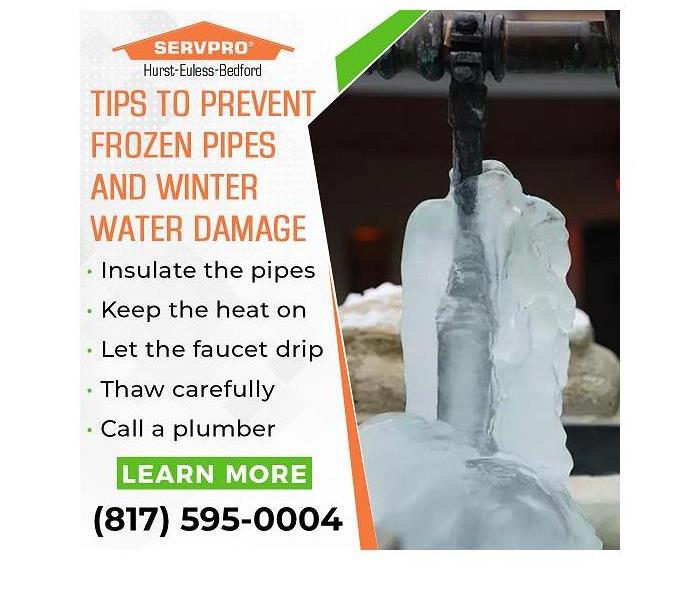Simple tricks to avoid frozen pipes and winter water damage
12/21/2021 (Permalink)
Blog summary: The SERVPRO blog gives insight into the various causes of frozen pipes and ways to prevent the damage they may cause.
Tips to prevent frozen pipes and winter water damage
Come winters, the plunging temperatures often cause the pipes to freeze and disrupt the plumbing system, eventually leading to the bursting of pipes and enormous water damage. But this damage can be prevented by following some simple steps as shared by SERVPRO of Hurst-Euless-Bedford in the blog below.
What causes pipes to burst?
At a temperature of 32 degrees Fahrenheit, water expands, and its density decreases. This expansion creates immense pressure on its container, anywhere between 50,2000 and 114,000 psi. Irrespective of the material of the container, this tremendous pressure will cause it to burst. Pipes in exterior walls, crawl spaces, or outdoor faucets are especially prone to bursting when exposed to cold temperatures for any length of time. The consequent water damage and its repair costs can be prevented by following some basic preventive measures.
Several factors lead to frozen pipes such as:
- The type of building construction
- The quality and quantity of insulation
- The decline in temperature
- The direction and force of the wind
- Other weather-related conditions
Moreover, buildings with a poor design are unable to withstand severe weather sufficiently and can contribute to their damage. Rusted or corroded pipes make leaks more likely.
Pipe freezing can also be a particular problem in the warmer climates of southern states where buildings are not built to tolerate cold weather conditions. Damage occurs when the water supply is turned back on and the weakened pipes burst open.
During power outages, the pipes are likely to freeze as most of the heating systems are dependent on electricity.
Preventive measures
Property owners must deduce which pipes are a priority when inspecting and protecting pipes from freezing. As a general rule, exposed pipes in parts of a home without heat, pipes in exterior walls, and any plumbing or pipes on the exterior facing side of the home must be treated as a priority.
If the flow of water in faucets slows to a trickle during a cold snap, or if the property owners suspect that the pipes are vulnerable, action is necessary. Here are some preventive measures to make sure pipes don’t freeze:
- Insulate the pipes
Adequate insulation in the house, especially along exterior walls and in crawl spaces is crucial. Adding more insulation in the walls, attic, or along the overhanging eaves of a home is an inexpensive way to prevent water damage associated with pipe bursts. Insulate both hot and cold water pipes in these areas with a “pipe sleeve” or install UL-listed heat tape, heat cable, or similar materials.
- Keep the heat on
In the property owner’s absence, the thermostat should be set to somewhere around 55 degrees to prevent frozen pipes. However, it must be noted that the existing water in the pipes may still freeze during severe cold snaps. Draining the plumbing system thoroughly with compressed air to blow out the lines can ensure low spots are also devoid of water.
Additionally, open kitchen and bathroom cabinet doors to allow warmer air to circulate the plumbing.
- Let the faucet drip
A tiny trickle from faucets works like a charm. It reduces the pressure in the pipes and the constant flow of water through the pipes makes the freezing highly unlikely.
- Thaw carefully
- Identify the frozen pipes: If there is no water flow when a faucet is turned on, the likelihood of frozen pipes is high. Inspect under the sink to look for frost on the pipes or bulges in the waterline.
- Switch on the faucet: Turn on the faucet to keep the water flowing and prevent pipe freeze by relieving the water pressure. Both cold and hot water must be turned on full throttle during the thawing of pipes.
- Apply heat at the faucet: Pipes that have been identified as frozen can be thawed by applying gentle heat to the faucet with a hairdryer, small ceramic space heater, hot towels, or even electric heating cables. Heat must be applied until the full water pressure is restored.
- Call a plumber
Any existing cracks in the pipe must be addressed by a plumber immediately. This is imperative to prevent any further water damage and mold growth.
Why SERVPRO?
- SERVPRO uses state-of-the-art equipment to bring the damaged property back to its original state. SERVPRO of Hurst-Euless-Bedford is always updating its fleet and equipment so clients in Hurst, Euless, Bedford, or anywhere else can quickly access the services.
- With over 1,700 US and Canadian Franchise locations, SERVPRO is strategically positioned to respond faster to an emergency of any magnitude.
- The SERVPRO staff is highly trained in property damage restoration. They receive initial in-house training and constant skill up-gradation at the corporate training facility and also acquire the regular IICRC-industry certification.
For water damage restoration services, call SERVPRO of Hurst-Euless-Bedford today at (817) 595-0004 or e-mail at office@SERVPROheb.com






 24/7 Emergency Service
24/7 Emergency Service
